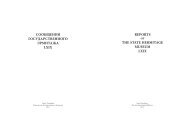The STaTe hermiTage muSeum annual reporT
The STaTe hermiTage muSeum annual reporT
The STaTe hermiTage muSeum annual reporT
Create successful ePaper yourself
Turn your PDF publications into a flip-book with our unique Google optimized e-Paper software.
compoSiTion of <strong>The</strong> <strong>hermiTage</strong> collecTionS as of 1 January 2011<br />
<strong>The</strong> State Hermitage Museum inventory contains<br />
2,970,214 items<br />
Including:<br />
paintings 16,851<br />
graphic works 622,172<br />
sculptures 12,623<br />
objects of applied art 301,512<br />
archaeological artifacts 738,389<br />
numismatic objects 1,132,627<br />
other items 146,040<br />
2,880 exhibits (as per inventory) entered the<br />
State Hermitage Museum in 2010 as gifts and<br />
acquisitions through the museum’s Purchasing<br />
Commission and archaeological expeditions.<br />
In 2010 the Research Library of the State Hermitage<br />
Museum purchased 4,110 books as well<br />
as Russian and foreign magazines of 235 names<br />
and received 2,520 editions through the international<br />
and Russian book exchanges.<br />
1,433 publications were sent to other libraries<br />
in accordance with the international book<br />
exchange terms.<br />
J moST noTaBle acQuiSiTionS of 2010<br />
collecTion of decoraTive porcelain<br />
from <strong>The</strong> pariS gallery popov & co.<br />
149 items<br />
Acquired through the Purchasing Commission<br />
<strong>The</strong> collection, as well as the gallery itself, was founded<br />
by Alexander Popov, whose extraordinary talent was nourished<br />
by Russian cultural ideals, including the admiration<br />
of eighteenth-century art. As a professional officer, Popov<br />
took part in the First World War. He moved to France in<br />
1919 and a year later opened an antiques shop opposite<br />
the Élysée Palace. In 1935, the gallery won the first honorary<br />
Paris Grand Prix for the exceptionally high quality<br />
of the works exhibited there. Many items are well known:<br />
they have been successfully displayed at international exhibitions<br />
and repeatedly published.<br />
<strong>The</strong> historical and cultural phenomenon that is this art<br />
collection was formed for nearly a century in the circle of<br />
prominent émigré Russians. Among Alexander Popov’s<br />
friends were Alexander Benois, Zinaida Serebryakova,<br />
Konstantin Somov, Yuri Annenkov, Feodor Chaliapin,<br />
Konstantin Korovin, Serge Lifar, Dmitry Bouchéne, Sergei<br />
Ernst, Natalia Goncharova, and many other eminent cultural<br />
figures who found themselves in Paris after the October<br />
revolution. <strong>The</strong>se acquaintances largely explain the<br />
fact that the collection mainly acquired objects brought<br />
from Russia by emigrants. <strong>The</strong> Popov Gallery obtained<br />
works of art from the splendid collections of the Princes<br />
Saltykov, Dolgorukov, Beloselsky-Belozersky, Orlov, the<br />
Duke of Leuchtenberg and many others.<br />
Objects from a coffee service with Cupids. Early 1760s<br />
Plate from the Yacht Service. 1785–1787<br />
<strong>The</strong> Popov & Co Gallery has always taken special pride in<br />
its unique porcelain. Alexander Popov himself was an accepted<br />
connoisseur in this field. His collection was highly<br />
praised by Alexander Benois: “… Mr. Popov has assembled<br />
his own collection of Russian porcelain, which numbers<br />
hundreds of pieces and contains a multitude of objects<br />
which has never before been seen in private collections<br />
and which could be envied even by such museums as the<br />
Hermitage” (1952). <strong>The</strong> then Director and Curator of the<br />
Hermitage Sergei Troynitsky visited the Paris gallery several<br />
times. <strong>The</strong> most important and interesting part of the<br />
acquired set is the Russian porcelain of the second half<br />
of the 18th century, first and foremost among which are the<br />
products of the St. Petersburg Imperial Porcelain Factory:<br />
Jug painted in the chinoiserie style. Early 1760s<br />
Soup plate from Empress Elizabeth’s Personal Dinner and Dessert Service.<br />
At the earliest 1756 – early 1760s<br />
– early porcelain pieces dating back to the reign of Empress<br />
Elizabeth;<br />
– pieces from tea and coffee sets, plates, basins and bowls<br />
for cooling bottles and glasses, with stamps in the shape<br />
of double-headed eagles made by Dmitry Vinogradov, the<br />
inventor of Russian porcelain;<br />
– a plate signed by the court manufactory painter G. Nikiforov,<br />
which is the first known signed specimen from the<br />
St. Petersburg Factory (late 1750s – early 1760s);<br />
– a typical example of the Vinogradov period – an Easter<br />
egg with “floral painting” (1750s), decorated in a highly<br />
detailed way betraying the manner of Elizabethan masters;<br />
– a number of pieces from a series known as “series with<br />
polychrome Chinamen” (late 1750s – early 1760s), among<br />
Easter egg with a floral design. 1750s<br />
most notable acquIsItIons of 2010<br />
14 15




